AMD A10-5800K & A8-5600K Review: Trinity on the Desktop, Part 1
by Anand Lal Shimpi on September 27, 2012 12:00 AM ESTAfter years of waiting, AMD finally unveiled its Llano APU platform fifteen months ago. The APU promise was a new world where CPUs and GPUs would live in harmony on a single, monolithic die. Delivering the best of two very different computing architectures would hopefully pave the way for a completely new class of applications. That future is still distant, but today we're at least at the point where you can pretty much take for granted that if you buy a modern CPU it's going to ship with a GPU attached to it.
Four months ago AMD took the wraps off of its new Trinity APU: a 32nm SoC with up to four Piledriver cores and a Cayman based GPU. Given AMD's new mobile-first focus, Trinity launched as a notebook platform. The desktop PC market is far from dead, just deprioritized. Today we have the first half of the Trinity desktop launch. Widespread APU availability won't be until next month, but AMD gave us the green light to begin sharing some details including GPU performance starting today.
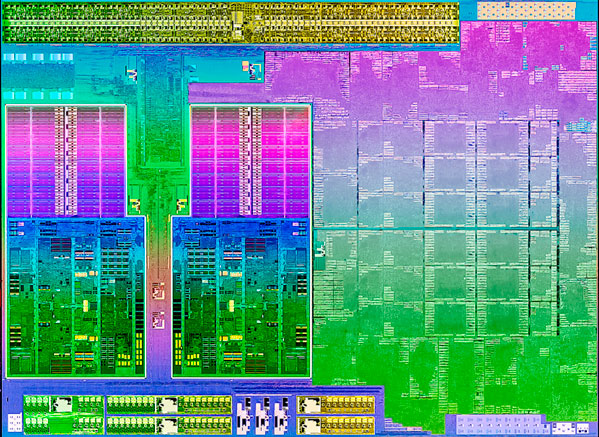
AMD's Trinity APU, 2 Piledriver modules (4 cores)
We've already gone over the Trinity APU architecture in our notebook post earlier this year. As a recap, Piledriver helped get Bulldozer's power consumption under control, while the Cayman GPU's VLIW4 architecture improved efficiency on the graphics side. Compared to Llano this is a fairly big departure with fairly different CPU and GPU architectures. Given that we're still talking about the same 32nm process node, there's not a huge amount of room for performance improvements without ballooning die area but through architecture changes and some more transistors AMD was able to deliver something distinctly faster.
| Trinity Physical Comparison | |||||
| Manufacturing Process | Die Size | Transistor Count | |||
| AMD Llano | 32nm | 228mm2 | 1.178B | ||
| AMD Trinity | 32nm | 246mm2 | 1.303B | ||
| Intel Sandy Bridge (4C) | 32nm | 216mm2 | 1.16B | ||
| Intel Ivy Bridge (4C) | 22nm | 160mm2 | 1.4B | ||
On the desktop Trinity gets the benefit of much higher TDPs and thus higher clock speeds. The full lineup, sans pricing, is below:
Remember the CPU cores we're counting here are integer cores, FP resources are shared between every two cores. Clock speeds are obviously higher compared to Llano, but Bulldozer/Piledriver did see some IPC regression compared to the earlier core design. You'll notice a decrease in GPU cores compared to Llano as well (384 vs. 400 for the top end part), but core efficiency should be much higher in Trinity.
Again AMD isn't talking pricing today, other than to say that it expects Trinity APUs to be priced similarly to Intel's Core i3 parts. Looking at Intel's price list that gives AMD a range of up to $134. We'll find out more on October 2nd, but for now the specs will have to be enough.
Socket-FM2 & A85X Chipset
The desktop Trinity APUs plug into a new socket: FM2. To reassure early adopters of Llano's Socket-FM1 that they won't get burned again, AMD is committing to one more generation beyond Trinity for the FM2 platform.
The FM2 socket itself is very similar to FM1, but keyed differently so there's no danger of embarrassingly plugging a Llano into your new FM2 motherboard.
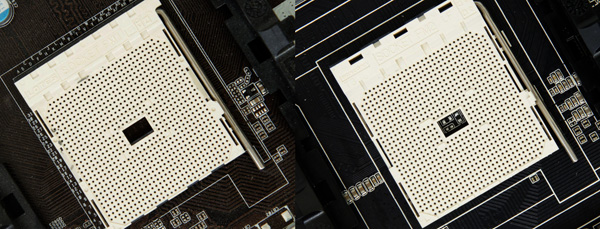
Socket-FM1 (left) vs. Socket-FM2 (Right)
AMD both borrows from Llano as well as expands when it comes to FM2 chipset support. The A55 and A75 chipsets make another appearance here on new FM2 motherboards, but they're joined by a new high-end option: the A85X chipset.
The big differentiators are the number of 6Gbps SATA and USB 3.0 ports. On the A85X you also get the ability to support two discrete AMD GPUs in CrossFire although obviously there's a fairly competent GPU on the Trinity APU die itself.
The Terms of Engagement
As I mentioned earlier, AMD is letting us go live with some Trinity data earlier than its official launch. The only stipulation? Today's preview can only focus on GPU performance. We can't talk about pricing, overclocking and aren't allowed to show any x86 CPU performance either. Obviously x86 CPU performance hasn't been a major focus of AMD's as of late, it's understandable that AMD would want to put its best foot forward for these early previews. Internally AMD is also concerned that that any advantages it may have in the GPU department are overshadowed by their x86 story. AMD's recent re-hire of Jim Keller was designed to help address the company's long-term CPU roadmap, however until then AMD is still in the difficult position of trying to sell a great GPU attached to a bunch of CPU cores that don't land at the top of the x86 performance charts.
It's a bold move by AMD, to tie a partial NDA to only representing certain results. We've seen embargoes like this in the past, allowing only a subset of tests to be used in a preview. AMD had no influence on what specifics benchmarks we chose, just that we limit the first part of our review to looking at the GPU alone. Honestly with some of the other stuff we're working on I don't mind so much as I wouldn't be able to have a full review ready for you today anyway. Our hands are tied, so what we've got here is the first part of a two part look at the desktop Trinity APU. If you want to get some idea of Trinity CPU performance feel free to check out our review of the notebook APU. You won't get a perfect idea of how Piledriver does against Ivy Bridge on the desktop, but you'll have some clue. From my perspective, Piledriver seemed more about getting power under control - Steamroller on the other hand appears to address more on the performance side.
We'll get to the rest of the story on October 2nd, but until then we're left with the not insignificant task of analyzing the performance of the graphics side of AMD's Trinity APU on the desktop.
The Motherboard
AMD sent over a Gigabyte GA-F2A85X-UP4 motherboard along with an A10-5800K and A8-5600K. The board worked flawlessly in our testing, and it also gave us access to AMD's new memory profiles. A while ago AMD partnered up with Patriot to bring AMD branded memory to market. AMD's Performance line of memory includes support for AMD's memory profiles, which lets you automatically set frequency, voltage and timings with a single BIOS setting.
We've always done these processor graphics performance comparisons using DDR3-1866, so there's no difference for this review. The only change is we only had to set a single option to configure the platform for stable 1866MHz operation.
Processor graphics performance scales really well with additional memory bandwidth, making this an obvious fit. There's nothing new about memory profiles, this is just something new for AMD's APU platform.


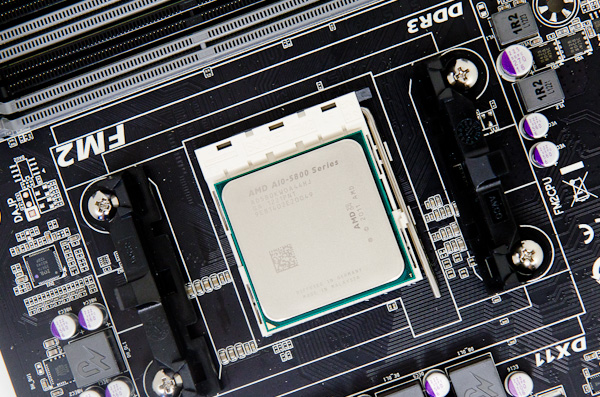
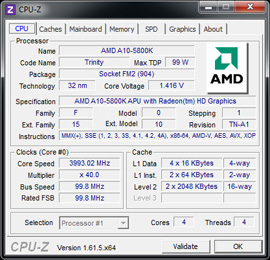
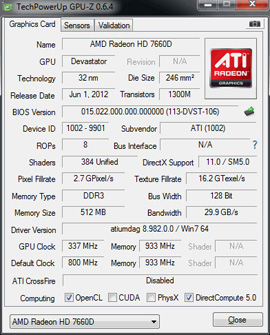
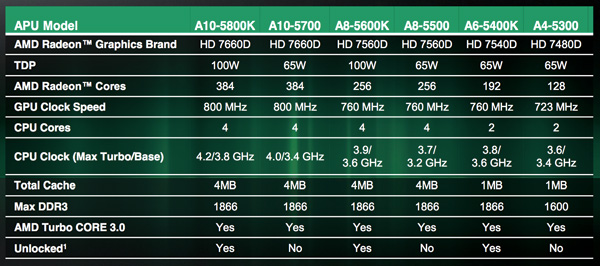

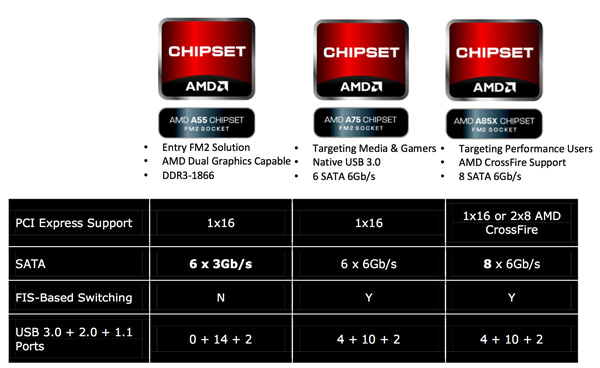






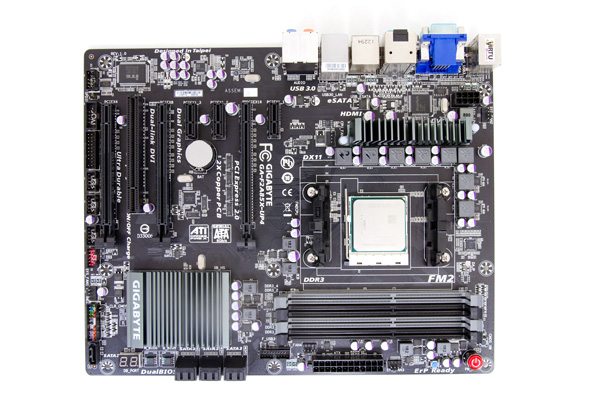

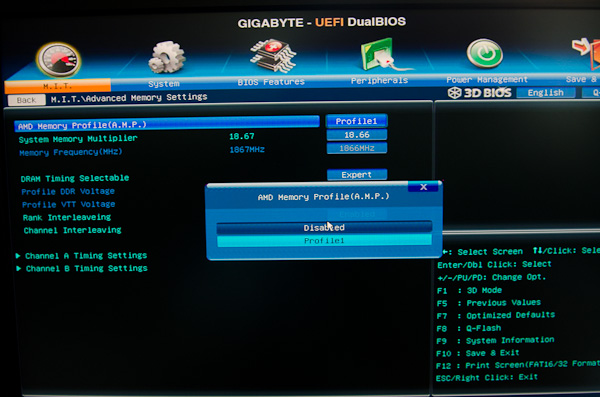








139 Comments
View All Comments
Voldenuit - Thursday, September 27, 2012 - link
Agreed. If anything, AMD's PR moves are a faux pas, because it leads the reader to wonder just how bad their x86 performance might be if they have to go behind readers' backs to manipulate public perception by forcing reviewers to cherry pick benchmarks.In reality, I expect Trinity's x86 performance to be acceptable, but AMD's tiered benchmark and preferential treatment of reviewers sets a bad precedent for the industry that Anand should not have agreed to.
Hubb1e - Thursday, September 27, 2012 - link
Think of this like the launch of the AMD 7660 D graphics card then have a cup of tea, and maybe you will feel better about it.I'm happy to have something to read about. They didn't have to release anything until Oct 2nd.
It sounds like a pretty decent GPU. It's something I can toss in the wife's computer and guests could have a pretty decent expeirence when they come over and I don't even have to worry about that extra idle power consumption of a graphics card that goes unused by my wife.
But, look at those die sizes. Anand compares them to the i5 since it shows them in a more favorable light. Drop the Ivy i3 in that chart at 116mm2 and Trinity looks like the fat girl at a wet T-shirt contest. She's got the biggest jugs but the sacrifice to get there may not be worth it.
CeriseCogburn - Thursday, October 11, 2012 - link
AMD is an evil, vile corporate pig filled with lies and spinmeisters toying with the pliable minds of the immensely ignorant fanbase of haters it has carefully developed over many years.Now it has turned fully to the darkside and launched an attack from it's crumbling deathstar, an attack never seen before. It's the head pig destroyer of review sites.
Be proud amd fans, all those years you fed on your hatred of nVidia and Intel, yesss... feel the hatred... let it flow through you...
You're no Luke Skywalkers, you have given in to the darkside....
Anand Lal Shimpi - Thursday, September 27, 2012 - link
It's a bolder move than manufacturers have tried in the past, but it's not unheard of. Most company sanctioned pre-release reviews have some sort of restriction put on them. No pricing discussion is not unusual, the GPU-focus here is unusual but not totally out of the ordinary. The original Intel sanctioned Conroe performance previews were done similarly (Intel set and controlled the only applications that could be tested).The original press embargo for Trinity was in October. If you wanted to show something earlier, these were the rules. I'm not a huge fan of staggered embargoes, but they exist and this wasn't the first one. Had AMD tried at all to influence the benchmarks we ran, tests we used or conclusions we came to I guarantee you that things would've unfolded very differently.
Take care,
Anand
juampavalverde - Thursday, September 27, 2012 - link
Its a known move from the manufacturers, and knowing what happens with the NDA's its hard, but also its the case of a product with a performance hard to measure at least in the individual metrics, because has everything onboard, so i have no chance of getting any conclusion just knowing half of the data, i dont know how much of the power comes from the IGP, or the CPU, or how powerul is the GPU in comparison with others in an apples to apples test (i dont know if every GPU was tested over the APU or in another test rig), and if the piledriver quad its holding back the whole APU or it is doing right. From the performance measured in the IGP, its just a meh comparing to Llano, and not far enough from the HD 4000.AMD its MAD if they want to play Intel games. Intel can do it because they control the market, but being the underdog, performing unspectacular and behaving mad and bad... oh dear... they will be bought by Qualcomm when their stock go further down.
Voldenuit - Thursday, September 27, 2012 - link
Anand, thank you for taking the time to respond with your thoughts.I do agree with you that this behaviour is not unprecedented in the industry, and all camps (red, blue, green) have done it at some point or another.
However, when Conroe previews were released, they were clearly marked as such.
The Trinity reviews out now might be more properly termed as previews, since the part is not available and will not be for a couple more weeks.
At the end of the day, the performance will be nothing unusual or unexpected, since we've had mobile trinity parts benchmarked for a while.
What worries me is that staged and staggered reviews under NDA and exclusivity clauses may become the norm if the rest of the industry picks up on this practice and runs with it.
I also don't think this PR stunt has worked in AMD's favor - rather than highlighting its (well-earned) GPU prowess, it's raising questions about its x86 performance (which are probably very close to the mobile part's documented performance) and the (probably unintended) ethics of attempting to influence the review process.
tecknurd - Thursday, September 27, 2012 - link
After reading that article at techreport.com, I can not believe that Anandtech have resorted to obey AMD's rules of reviewing the latest products. I was wondering where is the general usage benchmarks and where is the encoding benchmarks. I thought this is a review site and not some teaser. If I was a reviewer, I would post the benchmarks of general usage which means going against the email. A reporter has every right post the truth. Where is the truth on this site?Like I comment on other sites, AMD arrogance is ruin their reputation and the reputation of reviewers.
BTW, I doubt the email will hold up in court, so it is OK to disobey it unless the contract is ambiguous.
SleepyFE - Thursday, September 27, 2012 - link
OMG.Forget the e-mail, they signed an NDA!!
And there is truth in the article, just not the whole truth. You don't post everything that happens to you on facebook do you? Some thing are left out for whatever reason Consider the NDA as AMD's privacy settings.
Jamahl - Thursday, September 27, 2012 - link
Scott also "previewed" conroe under the kinds of limitations Anand spoke about.http://techreport.com/review/9538/intel-conroe-per...
The main difference is he didn't complain bitterly about it. Techreport doesn't have the staff to get these kinds of reviews done in time, so instead they take the easy option by slagging off AMD.
MrSpadge - Thursday, September 27, 2012 - link
It's not review of the product, but it's a review of the GPU performance. Period.